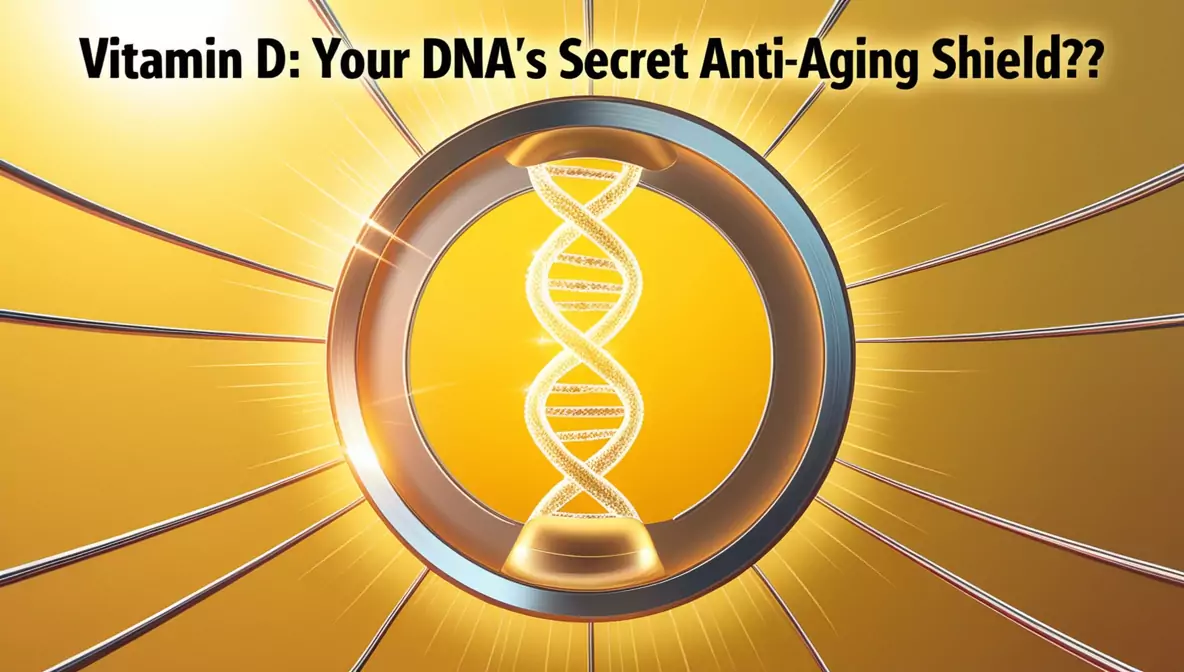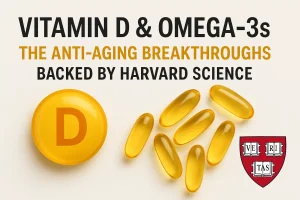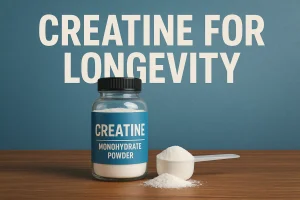Anti-Aging Breakthroughs Backed by Harvard Science : Vitamin D & Omega-3s
Vitamin D & Omega-3s: Anti-Aging Breakthroughs Backed by Harvard Science
Wrinkles are just the surface. Deep inside your cells, tiny “timekeepers” called telomeres dictate how fast you age—and new Harvard research reveals a shocking truth: Over 40% of adults are unknowingly accelerating their biological aging by neglecting a single nutrient.
In a landmark 5-year study of 1,071 people, scientists discovered that 2,000 IU of vitamin D3 daily preserved telomere length so effectively, it reduced cellular aging by nearly 3 years. This often-overlooked vitamin, distinct from omega-3s or antioxidants, plays a unique role in safeguarding the delicate ends of your DNA from shortening.
But there’s a catch: Get the dosage wrong, and you risk toxic side effects. Here’s how to harness vitamin D’s anti-aging power—safely and scientifically.
Vitamin D: Your DNA’s Secret Anti-Aging Shield?

Hook: “Forget expensive serums—Harvard scientists found a $0.25 daily habit that may slow cellular aging by 3 years.”
The Science:
What Are Telomeres—and Why Should You Care?
Picture the small plastic or metal caps on the ends of shoelaces. That’s essentially what telomeres are for your DNA: protective caps at the end of chromosomes that prevent genetic “fraying” during cell division. Every time your cells divide, telomeres shorten—a natural process tied to aging. But when they become too short, cells stop dividing or malfunction, increasing the risk of age-related diseases like cancer, cardiovascular disease, and cognitive decline.
The Harvard VITAL Trial Breakthrough
In one of the largest and most robust studies of its kind—the VITAL trial—Harvard researchers followed over 25,000 adults for more than five years to explore the effects of vitamin D and omega-3 supplementation. A compelling sub-analysis focused on telomere length: individuals taking 2,000 IU of vitamin D3 daily preserved their telomere length significantly better than those taking a placebo. While telomeres naturally shorten with age, this subtle preservation equated to a biological aging advantage of roughly three years.
Why Telomeres Matter Beyond Vanity
Short telomeres don’t just reflect aging—they help drive it. Shortened telomeres are associated with increased oxidative stress, chronic inflammation, and DNA damage. By preserving telomeres, vitamin D may help delay the cellular dysfunction at the root of many chronic conditions—not just wrinkles and gray hair. This means vitamin D is potentially acting at the deepest layer of aging, not merely cosmetic markers.

The Biological Rationale: How Vitamin D Helps
Vitamin D functions like a hormone in the body, interacting with receptors on nearly every cell. It helps reduce chronic low-grade inflammation—one of the key accelerators of telomere erosion—by modulating immune responses and lowering markers like CRP and IL-6. It also supports DNA repair mechanisms and protects against oxidative stress, two major threats to telomere integrity.
Vitamin D isn’t just about bone health—it could be your cellular armor against aging. A simple, affordable supplement may help slow the biological clock by protecting your DNA’s most fragile end caps. Staying consistent is key: this is a daily dedication, not a one-time solution.
Sunlight vs. Supplements: The Vitamin D Dilemma
Hook: “Sunscreen blocks 97% of vitamin D production. Here’s how to stay sun-safe without accelerating aging.”

Why We’re Deficient—Even in Sunny Climates
You might assume living in a sunny area protects you from deficiency—but it’s not that simple. Around 42% of U.S. adults have suboptimal vitamin D levels. The culprits? Modern lifestyles and melanin’s protective effect. Individuals with darker skin generate lower amounts of vitamin D from equivalent sun exposure. Older adults also generate less vitamin D in response to UVB rays. And SPF 30 sunscreen, while essential for skin cancer prevention, reduces vitamin D synthesis by a staggering 97%. Add to that more time indoors, clothing coverage, and winter months, and you’ve got a near-perfect recipe for deficiency.
Where to Get Vitamin D—And Why Food Usually Falls Short
Although some foods provide vitamin D, achieving optimal levels through diet alone is challenging. For example:
- Wild-caught salmon (3 oz): ~600–1,000 IU
- UV-exposed mushrooms (1 cup): ~400 IU
- Fortified milk (1 cup): ~100 IU
The average adult would need 6–10 servings of these foods daily to reach the levels shown to protect telomeres in clinical trials. Given that, supplementation becomes a practical and necessary strategy for most adults—especially those over 50.
How Much Is Enough? The Supplementation Sweet Spot
The RDA (Recommended Dietary Allowance) for adults is 600–800 IU/day—but this was designed to prevent bone disease, not optimize cellular aging. In the VITAL trial, participants took 2,000 IU/day—a dose well-tolerated in most healthy adults and shown to have protective effects on telomere length. While that dose is considered safe by the Endocrine Society, individuals should test their blood levels and consult a healthcare provider before starting, especially if they have underlying conditions or take medications that affect calcium metabolism.

Can You Just Get Sunlight Instead? Yes—But With Caveats
Direct sun exposure can stimulate natural vitamin D synthesis in just 10–30 minutes, depending on skin tone and time of day. But this comes with trade-offs:
- Risk of UV damage and skin cancer
- Variability due to latitude, season, cloud cover, and pollution
- Limited synthesis in older adults or those with higher melanin levels
That’s why experts recommend combining modest, safe sun exposure (early morning or late afternoon, without burning) with low-risk, targeted supplementation.
Relying solely on sunlight or diet rarely cuts it—especially after 50. The key is smart supplementation, guided by blood tests, balanced with safe sun habits. When it comes to slowing cellular aging, prevention beats guesswork.
The Telomere Takedown: How Aging Works at 50+
Hook: “Your cells have an expiration date counter. Here’s how to reset it.”

What Are Telomeres—and Why They’re Aging’s Front Line
Whenever a cell divides, it duplicates its DNA. But due to the way DNA replication works, a tiny bit of the chromosome’s end is lost with each division. That’s where telomeres come in—these repetitive, non-coding sequences act as buffers, preventing essential genetic material from being lost. Think of them as lifespan indicators built into each cell.
As telomeres shorten, the risk of cellular senescence rises—where cells stop dividing but don’t die. These “zombie cells” secrete inflammatory compounds, damage nearby tissues, and are now considered drivers of age-related decline, from cardiovascular disease to cognitive impairment.
Why Aging Accelerates After 50
After midlife, the body’s ability to repair DNA, maintain telomere length, and suppress chronic inflammation begins to falter. Oxidative stress builds. Mitochondria slow down. The immune system weakens. Telomere shortening speeds up—and the consequences are more than skin-deep:
- Heart disease and stroke risk climbs
- Cognitive decline accelerates
- Cancer becomes more likely due to genomic instability
- Weakness and tiredness grow as muscle and tissue repair processes slow down.
In short, aging isn’t just about how you look—it’s about how well your cells continue functioning.
Vitamin D’s Cellular Role in Slowing the Clock
Here’s where vitamin D comes in. Its active form, calcitriol, regulates hundreds of genes involved in immune function, inflammation, and DNA repair. Research shows vitamin D:
- Reduces systemic inflammation, a major driver of telomere erosion
- Boosts antioxidant defenses, helping combat oxidative stress
- Promotes the function of telomerase, the enzyme that aids in preserving telomere length.
A 2020 review even found that individuals with higher vitamin D levels had significantly longer telomeres—even when controlling for age, BMI, and lifestyle factors.

Why Gray Hair Doesn’t Tell the Whole Story
Numerous signs of aging, such as graying hair and wrinkles, are noticeable but surface-level. Telomeres tell the deeper story. Two individuals may appear to be the same age externally, but their biological ages can differ significantly due to variations in telomere length. Those with shorter telomeres face significantly higher risks of chronic disease, hospitalization, and early mortality.
Aging isn’t just a surface phenomenon—it’s cellular. By protecting telomeres, especially after 50, you’re not just extending life—you’re extending the quality of life. Vitamin D silently but significantly supports that goal.
Vitamin D vs. Omega-3s: The Anti-Aging Showdown
Hook: “Harvard’s 5-year study reveals one nutrient slowed aging dramatically. The other? Surprisingly ineffective.”

The VITAL Trial: A Nutrient Cage Match
The VITAL trial, one of the most ambitious studies of its kind, followed 25,871 adults over five years, testing the effects of daily 2,000 IU vitamin D3 and 1 gram of omega-3 fatty acids. While both nutrients have been praised for longevity benefits, only one directly preserved telomere length—a key biomarker of biological aging. That winner? Vitamin D.
The telomere sub-analysis revealed that participants taking vitamin D supplements preserved telomere length more effectively than those in the placebo group. In contrast, omega-3s showed no statistically significant effect on telomere preservation. For those looking to slow cellular aging, that’s a critical distinction.
But Don’t Dismiss Omega-3s Yet
While omega-3s may not have moved the needle on telomeres alone, they earned redemption in another major study: the DO-HEALTH trial. This European, multi-center study looked beyond telomeres, tracking markers of epigenetic aging—how chemical changes to your DNA affect how it’s read and expressed over time.

Participants who combined omega-3 supplementation (1g/day) with regular exercise (30 minutes, 3 times per week) experienced an epigenetic age deceleration of 3.8 months compared to controls. This suggests that omega-3s don’t act in isolation—they appear to synergize with physical activity to promote healthier aging at the gene-regulation level.
Context Is Everything: Who Benefits Most?
The DO-HEALTH trial also revealed that not everyone saw the same anti-aging effects. The biggest improvements were seen in:
- Non-obese participants (BMI <30)
- Those with adequate baseline vitamin D levels
- Participants who adhered to the exercise regimen consistently
In contrast, those who were overweight, sedentary, or deficient in vitamin D saw little to no benefit from omega-3s—highlighting that nutrients don’t work in isolation, and lifestyle context matters deeply.
Mechanisms: Why Vitamin D Works Solo, Omega-3s Don’t
Vitamin D modulates telomere biology directly by influencing inflammation, oxidative stress, and telomerase activity. It acts more like a hormone, regulating pathways that are tightly tied to cellular aging.

Omega-3s, by contrast, influence cell membrane fluidity, neuroinflammation, and metabolic health. These are important, but their anti-aging effects seem to require behavioral reinforcement (like exercise) to fully engage.
Vitamin D is your solo performer—it preserves telomeres independently. Omega-3s are the backup singers—they shine when paired with movement. If you’re choosing supplements for longevity, know what each one brings to the stage—and what it needs to work.
The Vitamin D Verdict: Should You Supplement After 50?
Hook: “New research says yes—but this mistake could damage your kidneys.”

Test, Don’t Guess: Get Your Blood Levels Checked
Before you start popping pills, know your baseline. A 25(OH)D blood test is the gold standard for assessing vitamin D status. The optimal range for overall health and aging prevention is generally 30–50 ng/mL, though some experts advocate for levels closer to 60 ng/mL in older adults or those at higher risk for deficiency.
Levels below 20 ng/mL are considered deficient and linked to increased risk of osteoporosis, cardiovascular disease, and even mortality. Testing gives you data—not assumptions—and helps personalize your dosage needs.
Dose Wisely: Don’t Overdo It
While 2,000 IU/day of vitamin D3 has been shown to preserve telomeres and is considered safe for long-term use in healthy adults, higher doses aren’t always better. Taking megadoses (e.g., 10,000 IU/day) without supervision can lead to vitamin D toxicity, especially when sustained over weeks or months.
Vitamin D is fat-soluble, which means it can build up in the body. Excess levels raise blood calcium, leading to nausea, confusion, kidney stones, and in severe cases, renal damage. That’s why medical oversight is essential—especially if you’re also taking calcium supplements or have kidney issues.
Maximize Benefits with Movement: The Synergy Factor
The DO-HEALTH trial showed that combining vitamin D, omega-3s, and strength training had measurable effects on healthy aging—especially in participants over 70. Those who exercised 30 minutes, three times a week not only preserved physical function but also slowed epigenetic aging when paired with proper nutrition.

Exercise acts as a biological amplifier: it reduces inflammation, supports mitochondrial health, and may enhance vitamin D metabolism in muscle and immune cells. The takeaway? Supplements work better when your body is moving.
Watch for Red Flags: Know the Signs of Over-Supplementation
Be alert to early symptoms of vitamin D overload, especially if you’re self-dosing without testing. Watch for:
- Nausea or vomiting
- Fatigue and muscle weakness
- Excessive thirst or frequent urination
- Calcium deposits in soft tissue (long-term risk)
If you’re taking supplements and experience these symptoms, get your blood levels and serum calcium tested immediately.
Yes, supplementing with vitamin D after 50 is not only smart—it’s scientifically supported. But this isn’t a set-it-and-forget-it solution. Personalize your dose, monitor your labs, and combine it with movement for best results. Aging may be inevitable—but how you age is increasingly within your control.
What About Genetic Testing? Personalizing Your Anti-Aging Plan
Hook: “Discover your biological age with a simple test—and learn how to turn back the clock.“

Why It Matters:
As the field of precision medicine grows, we’re learning that not everyone responds to vitamin D or omega-3s in the same way. Your genetics can influence how well you absorb, metabolize, and utilize these nutrients—especially vitamin D. Variants in genes like VDR (Vitamin D Receptor) and GC (Vitamin D Binding Protein) can affect your serum levels and the effectiveness of supplementation.
- People with certain VDR polymorphisms may need higher doses of vitamin D to achieve the same biological response.
- Others may convert vitamin D less efficiently, or store it differently based on fat tissue distribution or enzyme activity.
Enter Epigenetic Age Testing
In addition to tracking telomeres, companies now offer epigenetic clocks—blood or saliva-based tests that estimate your biological age by measuring DNA methylation patterns. Tests like GrimAge and Horvath Clock are backed by peer-reviewed research and can track how lifestyle and supplementation impact aging at a molecular level.

- You might want to explore testing to see how your body individually processes vitamin D and omega-3 fatty acids.
- Use epigenetic age testing as a feedback loop—adjust supplements and exercise, then re-test in 6–12 months.
- Talk to your doctor or a functional medicine specialist for interpretation and planning.
The future of anti-aging is personalized. Success varies from person to person—what helps one individual might not work as well for someone else. Genetic and epigenetic testing can help tailor your regimen—so you’re not just guessing, you’re aging smarter.
Final Thoughts: Age Is Just a Number—Biology Tells the Real Story
The science is clear: aging isn’t just about wrinkles or birthdays—it’s happening deep inside your cells. But the groundbreaking research from Harvard, DO-HEALTH, and others shows something even more powerful: you’re not just a passenger in the aging process—you’re the driver.
Vitamin D has emerged as a quiet hero, preserving telomeres, reducing inflammation, and helping your cells resist the wear and tear of time. Omega-3s, especially when paired with movement, offer another layer of support for long-term health and gene expression. Together, these nutrients—when used wisely—can help you age better, not just longer.
But the real magic happens when science meets strategy. Testing your blood, moving your body, personalizing your doses—these are the modern tools of aging well. It’s not about chasing youth. It’s about building resilience, maintaining energy, and showing up fully for the next chapter of your life.
Your next step? Start where it matters most: inside. Get tested. Get moving. Supplement smartly. Your telomeres—and your future self—will thank you.
Yes, but indirectly. A significant 2025 study, known as the VITAL trial, demonstrated that a daily intake of 2,000 IU of vitamin D3 helped maintain telomere length, the protective DNA structures, over a four-year period. Shorter telomeres equal accelerated cellular aging. This could translate to approximately 3 fewer years of biological aging for consistent users.
They didn’t – they work differently. In the VITAL trial, omega-3s had no significant effect on telomeres. But in the DO-HEALTH trial (2025), 1g/day of omega-3s slowed epigenetic aging by 3.8 months by altering gene expression. Different markers, different mechanisms.
Sunlight is ideal but unreliable:
- SPF 30 blocks 97% of vitamin D production
- Darker skin tones need 3–6 times more sun exposure
- Northern latitudes get inadequate UVB in winter
Supplements ensure consistency: 2,000 IU/day is effective (per trials), but always test blood levels first.
Yes, in rare cases. Vitamin D is fat-soluble and can accumulate. Doses above 4,000 IU/day long-term may cause:
- Hypercalcemia (excess calcium)
- Kidney stones or damage
Safety protocol: Blood test and doctor consultation before exceeding 2,000 IU.
Key groups in the research include:
- Non-white individuals (stronger telomere effects in VITAL)
- Non-obese adults (higher baseline vitamin D leads to better omega-3 response)
- Adults over 50 (accelerated telomere shortening starts midlife)
Synergy matters:
- Vitamin D preserves telomeres (DNA protection)
- Omega-3s slow epigenetic aging (gene expression)
The DO-HEALTH trial showed that combining them with strength training amplified anti-aging effects.
- Vitamin D preserves telomeres (DNA protection)
Request these blood tests:
- 25-hydroxy vitamin D: Optimal = 30–50 ng/mL
- Strive to achieve an Omega-3 Index of at least 8%. This index reflects the levels of EPA and DHA in your red blood cells.
Deficiency is common: 42% of U.S. adults lack sufficient vitamin D.
- 25-hydroxy vitamin D: Optimal = 30–50 ng/mL
Unlikely for most:
Top vitamin D foods:
- Wild salmon (988 IU/3.5 oz)
- UV-exposed mushrooms (400 IU/cup)
- Fortified milk (120 IU/cup)
Top omega-3 foods:
- Mackerel (4,580 mg/3.5 oz)
- Chia seeds (5,060 mg/oz)
Most adults need supplements to reach trial-effective doses.
The DO-HEALTH trial revealed:
- Omega-3s plus strength training synergistically slowed epigenetic aging
- Exercise reduces inflammation, omega-3s incorporate into cell membranes, enhancing cellular repair
Alone, neither was as powerful.
Not without medical guidance.
Do: Test levels, check kidney function, consult your doctor.
Don’t: Self-prescribe high doses if you have:
- Sarcoidosis
- Hyperparathyroidism
- Kidney disease
- History of kidney stones


